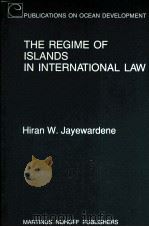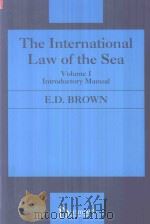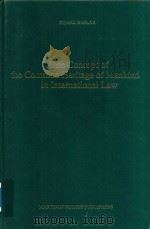《THE REGIME OF ISLANDS IN INTERNATIONAL LAW》
| 作者 | 编者 |
|---|---|
| 出版 | MARTINUS NIJHOFF PUBLISHERS |
| 参考页数 | 573 |
| 出版时间 | 1990(求助前请核对) 目录预览 |
| ISBN号 | 0792301307 — 求助条款 |
| PDF编号 | 812894458(仅供预览,未存储实际文件) |
| 求助格式 | 扫描PDF(若分多册发行,每次仅能受理1册) |

PART ONE:THE'REGIME OF ISLANDS'3
Chapter 1:INSULAR FEATURES:DEFINITION AND ENTITLEMENT3
1.Legal Definition of Islands and Other Natural Insular Features3
(1)Islands3
(2)Low-Tide Elevations6
(3)Artificial Islands7
2.The Entitlement of Islands to Areas of Maritime Jurisdiction9
(1)The Territorial Waters of Islands9
(2)The Contiguous Zones of Islands13
(3)The Continental Shelf of Islands14
(4)The Exclusive Economic Zones of Islands15
(5)Islands under Colonial Dependence,or Foreign Domination or Control16
PART TWO:THE EFFECT OF ISLANDS ON THE OUTER LIMITS OF NATIONAL JURISDICTION27
Chapter 2:ISLANDS AND BAYS27
1.Introduction27
(1)General27
(2)Geographical Situations28
2.Bays and Problems Occasioned by the Presence of Islands28
(1)Bays and Baselines28
(2)The Drawing of Baselines across Bays in the Presence of Islands30
(ⅰ)Problematical Island Situations33
(a)Screening Islands33
(b)Islands Forming the Headlands of a Bay36
(ⅱ)Construction of the Closing Line39
(ⅲ)Choice of Baselines40
Chapter 3:ISLANDS AND STRAIGHT BASELINES43
1.General43
2.Development of the Regime of Straight Baselines44
(1)Historical:Deliberations in Learned International Bodies and at the Hague Conference44
(2)The Anglo-Norwegian Fisheries Case of 195148
(3)The International Law Commission's Deliberations50
(4)The 1958 Geneva Conference on the Law of the Sea52
(5)The Third Conference on the Law of the Sea52
3.Criteria for the Application of Straight Baselines53
(1)Geographical Conditions53
(ⅰ)Coastal Configurations54
(ⅱ)Fringing Islands55
(2)Conformity with the General Direction of the Coast55
(3)The Link with the Land Domain:The Relevance of Economic and Historical Factors58
(4)Length of Baselines62
(5)Non-Exclusion of the Territorial Sea-High Seas/EEZ Link of Another State63
4.The Drawing of Straight Baselines in the Presence of Islands and Related Features63
(1)Coastal Islands63
(ⅰ)Fringing Islands64
(ⅱ)Island Clusters65
(ⅲ)Islands Constituting a Promontory65
(ⅳ)Individual Islands67
(2)Low-Tide Elevations68
(3)Insular Features Forming Part of a Delta74
(4)Island States,Outlying Islands,Archipelagic States not Qualifying for Archipelagic Straight Baselines and Other Archipelagos76
(ⅰ)Island States76
(ⅱ)Dependent Islands76
(ⅲ)Archipelagic States not Qualifying for Archipelagic Straight Baselines77
(ⅳ)Other Archipelagos77
(5)Archipelagic States Qualifying for Archipelagic Straight Baselines78
(6)Island Formations Extending across National Frontiers78
Chapter 4:REEFS AND ATOLLS89
1.On Reefs and Atolls in General89
2.Baselines in Relation to Reefs and Atolls95
(1)General95
(2)Law of the Sea Conferences and the Inclusion of Reefs and Atolls96
(ⅰ)Islands Situated on Atolls98
(ⅱ)Islands Having Fringing Reefs99
Chapter 5:MID-OCEAN ARCHIPELAGOS103
1.Introduction103
(1)General103
(2)The Feature103
(3)The Problem104
(4)The Rationale Underlying Archipelagic Claims106
(ⅰ)Political and Security Interests,Communications and the Exercise of the Public Law Jurisdiction of the Archipelagic Entity107
(ⅱ)Historical Factors108
(ⅲ)The Unity of the Archipelago as a Natural Feature108
(ⅳ)Economic Considerations109
(ⅴ)Preservation of the Environment110
(ⅵ)Factors Emphasized to Assuage International Concern110
(ⅶ)Evaluation110
(5)The Countervailing Interests112
(6)The Evolution of the Archipelago Concept113
2.Delimitation of the Baseline of the Territorial Sea Around Mid-Ocean Archipelagos:Archipelagic Straight Baseline Systems126
(1)General126
(2)The Juridical Basis for Delimiting Archipelagic Straight Baselines127
(ⅰ)The Fictive Bay Concept127
(ⅱ)The Normal Straight Baseline-Coastal Archipelago Analogy129
(ⅲ)The Historic Waters Approach130
(ⅳ)The Fictive Island Concept131
(ⅴ)The Case for a Special Regime of Archipelagic Straight Baseline Systems132
(3)The Problem of Defining a Mid-Ocean Archipelago:the Criteria for Determining the Applicability of an Archipelagic Straight Baseline System134
(ⅰ)The Definition of 'Archipelago'134
(a)The Natural Feature136
(b)Criteria Determining the Requisite Cohesiveness of the Features137
(ⅱ)The Geopolitical Scope of the Regime139
(a)The Question of Archipelagos Constituting Part of a Mainland State:State Archipelagos140
(b)The Archipelagic Entity142
(4)The Regime of Archipelagic Straight Baseline Systems142
(ⅰ)General Definitive Criteria143
(a)The Location of Basepoints143
(b)The Geopolitical Factor-Inclusion of the Main Islands144
(c)The Test of Proportionality:The Water-Land Ratio145
(ⅱ)Delimitation of Archipelagic Straight Baselines:Specific Restrictive Criteria146
(a)Limitations on the Length of Straight Baseline Segments147
(b)Conformity with the General Configuration of the Archipelago149
(c)The Integration of Low-Tide Elevations150
(ⅲ)Accommodation of the Interests of Other States150
(a)Avoidance of Screening Effects152
(b)Non-interference with Existing Rights152
(ⅳ)Public Notification of Archipelagic Baselines153
3.The Archipelagic Regime153
(1)Jurisdictional Limits in Outer Sea Areas153
(2)The Regime of Archipelagic Waters154
(ⅰ)Geographical Limits154
(ⅱ)Juridical Status155
(3)Exceptions to the Principle of Sovereignty over Archipelagic Waters156
(ⅰ)Established Rights and Preferential Rights156
(a)Preferential Rights of Immediately Adjacent Neighbouring States156
(b)Rights of States under Existing Agreements,and Existing Submarine Cables157
(ii)Rights of Passage through Archipelagic Waters158
(a)The Right of Innocent Passage160
(b)The Question of Passage through Archipelagic Straits and the Regime of Archipelagic Sea-Lanes Passage161
(4)Some Examples of State Practice Relating to Archipelagos171
(ⅰ)Ecuador171
(ⅱ)India171
(ⅲ)The Maldives172
(ⅳ)Fiji172
PART THREE:THE EFFECT GIVEN ISLANDS IN INTER-STATE DELIMITATION193
Chapter 6:ISLANDS IN INTER-STATE BOUNDARY RIVERS193
1.General193
2.Methods of Delimiting Inter-State Boundaries in Rivers194
3.The Treatment of Islands in Navigable Rivers where the Thalweg Constitutes the Boundary195
(1)General195
(ⅰ)The Thalweg as a River Boundary195
(ⅱ)Delimitation According to the Thalweg in the Presence of Islands198
(a)The General Rule198
(b)Application of the Thalweg Rule where a River Splits into Several Navigable Channels as a Result of the Presence of Islands198
(c)Exceptions to the General Rule200
(2)The Effect of a Change in the Geographical Situation201
(ⅰ)Alterations in the Thalweg201
(ⅱ)Alterations in the Thalweg and the Effect on Islands203
(3)Changes in the Insular Geography206
(ⅰ)Changes in the Occurrence of Islands206
(a)The Emergence of New Islands206
(b)The Case of Islands which Disappear and Reappear209
(c)'Mobile Islands'209
(ⅱ)Accretionary Changes210
(a)Islands Becoming Joined to a River Bank210
(b)Islands Becoming Joined to Each Other211
(c)Accretions to Islands212
(ⅲ)Fission:An Island is Split into Two or More Parts213
4.The Treatment of Islands in Rivers where the Medium Filum Aquae Constitutes the Boundary213
(1)General213
(ⅰ)The Medium Filum Aquae as a River Boundary213
(ⅱ)Delimitation According to the Medium Filum Aquae in the Presence of Islands214
(a)Construction of the Median Line in the Presence of Islands214
(b)Allocation of Sovereignty over Islands:The General Rule215
(c)Islands Located in the Middle of a River216
(2)The Effect of a Change in the Geographical Situation218
(ⅰ)Alterations of the Medium Filum Aquae218
(ⅱ)Alterations in the Medium Filum Aquae:The Effect on Islands219
(3)Changes in the Insular Geography219
(ⅰ)Changes in the Occurence of Islands219
(ⅱ)Accretionary Changes220
5.The Treatment of Islands in Rivers where the Bank Constitutes the Boundary221
(1)General221
(ⅰ)Utilization of the Bank as the Boundary221
(a)Where the Boundary is Constituted by the Banks of the River221
(b)Where the Boundary is Constituted by One Bank222
(c)The Definition of 'Bank'222
(ⅱ)Utilization of the Bank as a Boundary:Determination of the Status of Islands222
(ⅲ)Changes in the Geographical Situation:Alterations of the Bank and Insular Geography224
6.The Treatment of Islands in Rivers where Other Methods of Delimitation are Utilized224
(1)General224
(2)Delimitation According to Straight Line Segments:The Treatment of Islands225
(3)Ad Hoc Treatment226
Chapter 7:ISLANDS IN INTERNATIONAL LAKES237
1.General237
2.Methods of Delimiting Inter-State Boundaries in Lakes239
3.The Treatment of Islands in Delimiting Inter-State Boundaries in Lakes240
(1)The Treatment of Islands in International Lakes where the Median Line Constitutes the Boundary241
(ⅰ)Methods of Delimiting Median Line Boundaries in Lakes242
(a)A Line Being at All Points Equally Distant from Each Shore:The 'Landman's Median'242
(b)A Line Following the General Lines of the Shore Dividing the Surface of the Water Area as Nearly as Practicable into Two Equal Parts:An Approximate Median242
(c)A Line Along the Mid-Channel Dividing the Navigable Portion of the Lake,and Being at All Points Equally Distant from the Shoal Water on Each Shore:The Navigable Median242
(d)A Line Every Point of which is Equidistant from the Nearest Point or Points on Opposite Shores of the Lake:The Equidistance Line or Theoretical Median243
(ⅱ)The Treatment of Islands243
(a)Allocation of Sovereignty244
(b)Islands as Points of Measurement247
(2)The Treatment of Islands in International Lakes where the Shore Constitutes the Boundary248
(3)The Treatment of Islands in International Lakes where the Boundary is Constituted by the Main Navigable Channel or Lacustrine Thalweg249
(4)The Treatment of Islands in International Lakes where the Boundary is Constituted by Geometrical Lines250
Chapter 8:ISLANDS AND THE DELIMITATION OF INTERSTATE MARITIME BOUNDARIES259
1.General259
2.Principles and Methods for the Delimitation of Maritime Boundaries260
(1)Delimitation of the Territorial Sea260
(ⅰ)The Conventional Regime of the Territorial Sea:Part Ⅰ of the 1958 Geneva Convention on the Territorial Sea and Contiguous Zone:The Territorial Sea-Article 12:InterState Delimitation260
(a)The Legislative History of the Delimitation Provision260
(b)Analysis of the Rule of Territorial Sea Delimitation268
(ⅱ)The Third United Nations Conference on the Law of the Sea and the Rule for Inter-State Delimitation of the Territorial Sea277
(ⅲ)State Practice in the Delimitation of Territorial Sea Boundaries280
(2)Delimitation of the Contiguous Zone282
(ⅰ)The Conventional Regime of the Contiguous Zone:Part Ⅱ of the 1958 Geneva Convention on the Territorial Sea and Contiguous Zone:The Contiguous Zone-Article 24(3):Inter-State Delimitation282
(a)The Legislative History of the Provision282
(b)Analysis of the Provision283
(ⅱ)The Third United Nations Conference and the Question of Contiguous Zone Delimitation283
(ⅲ)State Practice in the Delimitation of Contiguous Zone Boundaries284
(3)Delimitation of the Continental Shelf285
(ⅰ)Article 6 of the 1958 Geneva Convention on the Continental Shelf:The Rule for Inter-State Delimitation of the Continental Shelf285
(a)The Legislative History of Article 6286
(b)Analysis of Article 6294
(ⅱ)The Third United Nations Conference on the Law of the Sea and the Rule for Inter-State Delimitation of the Continental Shelf308
(ⅲ)State Practice in the Delimitation of Continental Shelf Boundaries311
(4)The Rule for Inter-State Delimitation of the Exclusive Economic Zone312
(ⅰ)The Third United Nations Conference on the Law of the Sea and the Rule for Delimitation of the Exclusive Economic Zone312
(ⅱ)State Practice in the Delimitation of Exclusive Economic Zone Boundaries314
3.Equitable Delimitation of Maritime Boundaries315
(1)General315
(2)Historical Development of the Concept of Equitable Delimitation of Maritime Boundaries316
(3)Delimitation in Accordance with Equitable Principles324
(ⅰ)The Content and Scope of Equitable Principles324
(ⅱ)Relevant Circumstances328
4.Equidistance as a Method for the Delimitation of Maritime Boundaries334
(1)Equidistance-Principle and Method334
(2)Geometric Techniques for the Construction of Equidistance Lines335
(3)The Construction of an Equidistance Line in the Presence of Islands336
(4)Equidistance as a Method for the Delimitation of Maritime Boundaries346
(5)Equidistance-Special Circumstances:Inequities Associated with Equidistance Lines and Possible Remedies with Reference to Islands349
(ⅰ)The Effect of Islands on Lines of Equidistance-The Potential for Inequity349
(ⅱ)Means of Abating the 'Disproportionate' Effects of Islands in the Context of Equidistance Boundaries352
(a)No Effect to Islands354
(b)Partial or Reduced Effect(1)-Half Effect356
(c)Partial or Reduced Effect(2)-Other Values358
(d)Enclave Solutions-Enclaves and Semi-Enclaves359
(e)Areal Exchanges362
(f)Avoidance-Joint Development Zones and Other Arrangements363
5.The Role of Islands in the Delimitation of Maritime Boundaries:An Objective Analysis of the Practice of States365
(1)General365
(2)Territorial Sea Boundaries372
(ⅰ)State Practice372
(ⅱ)Conclusions389
(3)Maritime Boundaries Beyond the Territorial Sea391
(ⅰ)State Practice391
(ⅱ)Conclusions478
Selected Bibliography531
List of Figures539
Index of Islands545
General Index551
About the Author571
1990《THE REGIME OF ISLANDS IN INTERNATIONAL LAW》由于是年代较久的资料都绝版了,几乎不可能购买到实物。如果大家为了学习确实需要,可向博主求助其电子版PDF文件(由 1990 MARTINUS NIJHOFF PUBLISHERS 出版的版本) 。对合法合规的求助,我会当即受理并将下载地址发送给你。
高度相关资料
-

- THE RULE OF LAW IN INTERNATIONAL AFFAIRS
- 1998 MARTINUS NIJHOFF PUBLISHERS
-

- THE INTERNATIONAL LAW OF RECOGNITION
- 1951 STEVENS & SONS LIMITED
-

- THE NON-USE OF FORCE IN INTERNATIONAL LAW
- 1989 MARTINUS NIJHOFF PUBLISHERS
-

- THE TEACHER IN INTERNATIONAL LAW
- 1982 MARTINUS NIJHOFF PUBLISHERS
-

- THE ACQUISITION OF TERRITORY IN INTERNATIONAL LAW
- 1963 MANCHESTER UNIVERSITY PRESS
-

- THE CONCEPT OF TREATY IN INTERNATIONAL LAW
- 1996 KLUWER LAW INTERNATIONAL
-

- THE LAW OF INTERNATIONAL BUSINESS IN AUSTRALIA
- 1980 BUTTTERWORTHS
-

- The Exclusive Economic Zone Regime and Legal Nature Under International Law
- 1989 Cambridge University Press
-

- The International Law of the Sea
- 1994 Dartmouth
-

- The Concept of the Common Heritage of Mankind in International Law
- 1998 Martinus Nijhoff Publishers
-

- The Law of International Organisations
- 1996 Manchester University Press
-

- The Law of Recognition in International Law Basic Principles
- 1994 Edwin Mellen Press
-

- RIGHTSAND STATUS OF THE INDIDUAL IN INTERNATIONAL LAW
- 1984 DEEP & DEEP PUBLICATIONS
-

- The Law of International Trade
- 1993 Butterworth-Heinemann
-

- THE ELEMENTS OF INTERNATIONAL LAW
- 1967 THE DORSEY PRESS
提示:百度云已更名为百度网盘(百度盘),天翼云盘、微盘下载地址……暂未提供。➥ PDF文字可复制化或转WORD